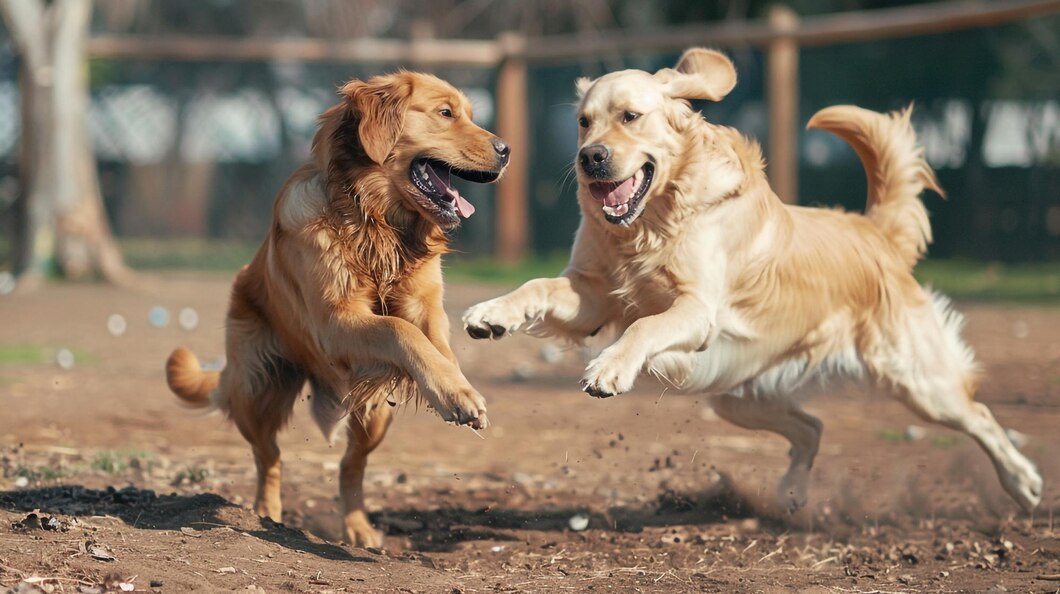Dogs are playing if their body language is relaxed, and there are frequent play bows. Growling and stiff posture may indicate fighting. Understanding whether dogs are playing or fighting is crucial for any dog owner.
Playful dogs exhibit relaxed body language, wagging tails, and a loose, bouncy gait. They often take turns chasing each other and frequently engage in play bows, signaling their friendly intentions.
Conversely, if dogs are fighting, you’ll notice stiff postures, raised hackles, and intense growling. Quick, sharp movements and a lack of breaks between interactions can also indicate aggression. Observing these behaviors helps ensure a safe and enjoyable environment for both dogs and their owners. Recognizing the differences can prevent potential injuries and foster healthier relationships among pets.
Body Language
Playful dogs often show a play bow. They lower their front legs and keep their rear up. Happy dogs have relaxed faces and wagging tails. They might also bounce around with loose, wiggly bodies. Playful pups may also chase each other and take turns being on top.
Aggressive dogs show stiff, rigid bodies. Their tails may be straight up or tucked between legs. Dogs might growl, snarl, or show their teeth. Ears are often pinned back or standing straight up. Watch for direct, hard stares. These signs mean the dogs are not playing.
Vocal Cues
Dogs make happy sounds while playing. These sounds include barking and yipping. Barking is often high-pitched. Yipping is usually short and quick. Both are signs of fun and excitement. Listen for playful growls. These growls are not deep or long. They sound more like purrs.
Warning growls are different. They are deep and long. These growls mean the dog is not happy. Watch for other signs. Stiff body and bared teeth are bad signs. Look for raised hackles. Raised hackles are the hair on the back. These signs mean the dog is angry or scared.
Facial Expressions
Dogs often show relaxed features when playing. Look for soft eyes and loose mouths. Ears may be slightly back or sideways. This shows they feel safe and happy. A wagging tail is also a good sign. Playful dogs often have a bouncy body language. They may take turns chasing each other. Play bows are common too. This is when they lower their front legs and keep their back end up.
Fighting dogs have tense faces. Look for stiff bodies and hard stares. Their mouths might be closed tight. Ears often point forward or are flat against their heads. Raised hackles on the back can be a sign of tension. Growling and snarling are clear signs. Watch for dogs that don’t take turns. If one dog seems scared, it might be a fight. Separate them if things get too intense.
Tail Movements
A wagging tail usually means a happy dog. Dogs wag their tails to show friendliness. Fast wagging often indicates excitement. A slower wag can mean curiosity.
A stiff tail can mean a dog is tense. Dogs with stiff tails might feel threatened. This can be a sign of aggression. A straight-up tail shows dominance. It’s important to watch for other body signals.
Play Bows
Dogs often use play bows as an invitation to play. The dog lowers its front legs and keeps its rear up. This posture signals friendly intentions. It says, “I want to play with you!” Dogs love this playful gesture. You might see wagging tails and happy barks.
Sometimes, play bows can be misinterpreted. Not all dogs understand this signal. One dog may think it’s a threat. This can lead to confusion and growling. Always supervise dog interactions. Look for other signs of play, like relaxed bodies and playful bounces. This helps ensure safe and happy playtime.
Pacing And Movement
Dogs often move in circles while playing. This shows they are having fun. Their bodies are loose and relaxed. Tails usually wag in a happy way. They might take turns chasing each other. This behavior is a good sign of playing.
During fights, dogs face each other directly. Their bodies may be tense. Growling and snarling are common. Ears could be pinned back. They might snap or bite. These signs indicate aggression. It’s important to separate them if fighting.
Bite Inhibition
Dogs often use their mouths to explore. Gentle mouthing is a sign of play. They may softly grab each other. This is a friendly gesture. No harm is meant. You can see relaxed body language. Tails may wag. Ears are not pinned back. Playful dogs often take turns. One dog bites softly. Then, the other dog does the same.
Hard bites can be a sign of aggression. Dogs might growl loudly. Their body may become stiff. Tails could be held high. Ears may be pinned back. This is not friendly behavior. Watch for blood or injuries. Separate the dogs if needed. They might need a break.
Intervention Tips
Watch the dogs’ body language closely. Playful dogs have relaxed bodies and wagging tails. Fighting dogs may show stiff postures and growling. Intervene if you see any signs of aggression. Separate the dogs if one seems scared or is trying to escape.
Use a loud noise like clapping to distract them. Avoid using your hands to separate fighting dogs. Use a large object like a broom to gently push them apart. Throw a blanket over them to create confusion and stop the fight.
Another Post: Why Does My Dog Throw Up Water After Drinking
FAQ
How Can I Tell If Dogs Are Playing?
Look for relaxed bodies, wagging tails, and play bows. Playful dogs also take turns being on top.
What Signs Indicate Dogs Are Fighting?
Raised hackles, growling, stiff bodies, and baring teeth signal aggression. Separate them immediately to prevent injury.
Can Dogs Switch From Play To Fight?
Yes, play can turn into a fight. Watch for escalating aggression and intervene if necessary.
Conclusion
Understanding dog behavior is crucial for pet owners. Recognize play signals like relaxed bodies and wagging tails. Watch for warning signs such as growling and stiff postures. Observing interactions helps ensure your pets’ well-being. By staying informed, you can foster a safe and happy environment for your furry friends.

